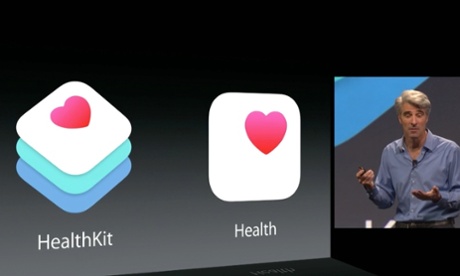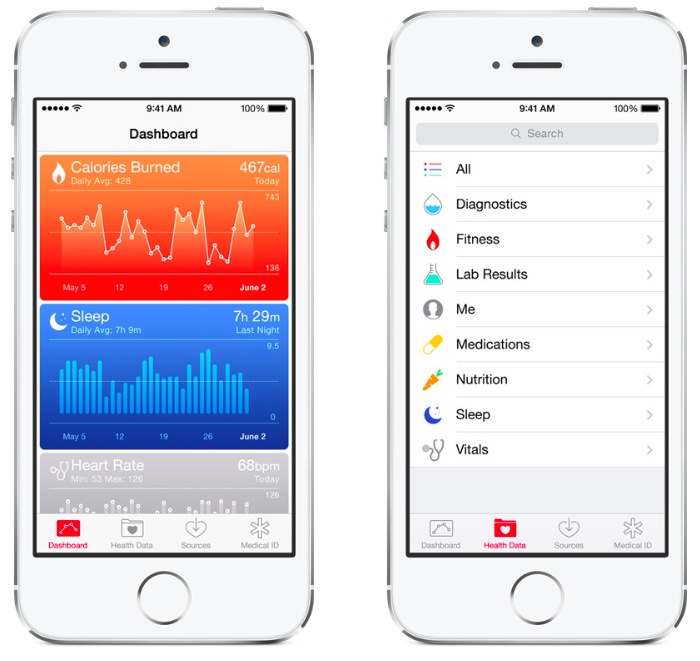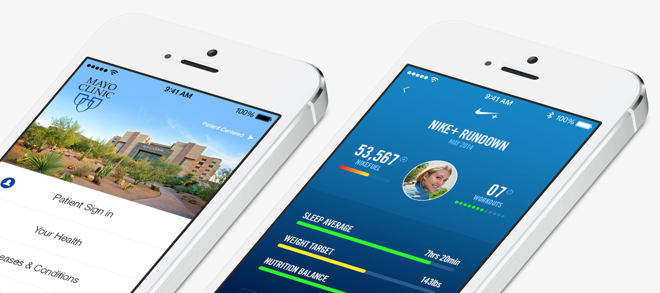Behind the apparently simple premise of Apple’s new Health app in iOS 8 is the potential to “solve one of the single worst problems in healthcare today,” wrote one healthcare professional: “the inability to easily transfer patient records from one care location to another.”
“What do doctors think of Apples HealthKit?” an Emergency Room doctor in training named Jae Won Joh shared a perspective that’s since earned upvotes by scores of other doctors and healthcare workers.
“It has tremendous potential,” Joh wrote. But that wasn’t his first impression. “I watched the keynote last night, and initially Healthkit seemed fairly unremarkable, just another way for consumer apps like Nike+ and sleep trackers to output their data into pretty charts,” he stated.
“A cursory look at their website (Apple – iOS 8 – Health) would seem to support the view that HealthKit is targeted at those obsessed with the ‘quantified self’ movement.”
Joh wasn’t impressed with the idea of a system app designed to simply track and graph what he called “fitness-oriented data,” such as calories burned, sleep and heart rate, the three dashboards visible in Apple’s Health app screen shot (above left).
However, looking at the second “Health Data” screen (depicted by Apple in the above right image), Joh observed that “from a clinical perspective, there are 4 key points of interest, particularly since Epic Systems (one of the largest EMR vendors in the US) was mentioned in the keynote.”
He highlighted Diagnostics, Lab Results, Medications and Vitals, and also called attention to a third screenshot showing a Medical ID, with Medical Conditions, Notes, Allergies & Reactions, and Medications.
“Suddenly, I’m interested,” he wrote.
“Imagine if with just your phone, you could travel with all of your former imaging studies (e.g. chest X-rays, CT scans). Your verified vaccination records. Your biopsy results. Your list of allergies. Your lab tests from the last 10, 15, 20 years. All the medications and doses you’ve ever been on, for what time period, and why. Your heart rate and blood pressure measurements from every clinic visit you’ve ever made. What if all of this was kept in the cloud, with instant access through your phone?” he wrote.
The onerous problem iOS 8 HealthKit has the potential to solve
“Take a moment to see how medical records currently go from institution to institution,” he wrote, linking to an outline he presented of the convoluted, archaic, problematic series of steps that hospitals and doctors currently struggle with.
“Facsimile.
“Yes, you read that correctly. In the 21st century, when the power of the internet can provide instant secure connectivity to transfer enormous quantities of data, U.S. hospitals pour millions and millions of dollars into EMRs that aren’t compatible with each other, necessitating reliance on an ancient technology from the ’60s unknown to the majority of human beings born in this country past 1995.”
He then detailed the difficulty of getting information from patients, who might be unconscious, unable to communicate, or without the capacity to consent access to necessary information.
If the patient remembers where they were previous treated, the attending doctor is then tasked with looking up the institution, if it is even still in operation, and then fill out an extensive form by hand that the patient can sign to release access to their medical information.
Part of the consent process requires that the doctor “spend time explaining to the patient why access to prior records is necessary,” and then “deal with patient reaction.”
The attending physician then has to send, by fax, the written consent, (“If this step fails, try not to feel too much frustration that I spent over 2 decades studying to become a doctor only to be stalled by a piece of hardware that even my parents didn’t own” he wrote) and then wait for hours for the other facility to find and return the patient’s medical records.
After finally receiving a reply, Joh commented that that incoming fax is likely to be “a bundle of grainy scanned papers from other facility,” which can’t be electronically searched, resulting in the need to “search through the entire stack (sometimes hundreds of sheets, depending on patient’s history) by hand to find what I need.”
Scenarios solved by patient carried, Touch ID secured Electronic Medical Records
“This could be revolutionary,” Joh noted, describing a couple scenarios where the technology behind HealthKit could both make life easier and even deliver life saving information.
During the HealthKit introduction at WWDC2014, Apple’s software chief Craig Federighi noted that The Mayo Clinic is working with Apple on a patient monitoring tool that ties into Health, so that when a patient takes a blood pressure measurement the data can be saved and checked against previous personal results. If a reading is abnormal, the data can be automatically sent to the patient’s doctor for quick and seamless response.
Apple’s discussions with the U.S. Food and Drug Administration indicated that Apple executives feel that mobile devices can do more to help people learn about themselves, and that they feel there “may be a moral obligation to do more.”
Filings revealed by the agency stated that “Apple will work closely with the FDA as they develop future products,” and that the company believes that “the earlier FDA is involved and advising, the less likely that Apple would be caught by surprise later when they wish to release a new product, if that product must be regulated.”
That supports the idea that Apple is working to broaden the scope of iOS 8 Health to include more sophisticated EMR features for patient data. Along those lines, Joh described a situation where there is a hypothetical “lung cancer patient in New York who wants to move to Michigan to be closer with her extended family,” who “now has significantly more peace of mind, knowing that her health data can easily move with her.
“She doesn’t have to drudge through the paperwork to release her own medical records from her prior hospital system. She doesn’t have to make a separate trip to the radiology department to have them burn her a CD/DVD of all of her imaging. She doesn’t have to burden her new oncologist with the task of sifting through hundreds of sheets of results by hand, as she can release them into the new EMR with a single tap of a finger. She doesn’t have to worry about whether the images on the disc will be compatible with her new radiologist’s system, as the cloud automatically adjusts the data format to match.”
In a second situation, Joh described a trauma patient “who arrives in a lower-acuity ER after a motor vehicle accident and is found to have a severe unstable ankle fracture on imaging.” With that Xray data uploaded to the cloud as part of the patient’s HealthKit medical record, he “can now be more easily transferred to a higher-level hospital with orthopedic surgery on call.”
As a result: “no drudging through paperwork. No waiting to process a CD/DVD. Less hassle. More clinical care.”
Joh concluded, “I feel that HealthKit might well be the first step in creating something akin to a universal EMR. If Apple pulls this off with the right partners,” he observed, “they could potentially solve one of the single worst problems in healthcare today: the inability to easily transfer patient records from one care location to another.”
Jon Steuernagle, an ICU doctor commenting on the subject added, “One of the most exciting breakthroughs in modern medicine. Getting your physical data, biometric data into the EMR and into your doctors hands. Just needs to be economically feasible for majority of people.”
Apple’s Health app is somewhat reminiscent of Passbook, the iOS 6 app Apple introduced to manage electronic tickets, boarding passes, coupons and other records. While many critics complained that they thought it wasn’t interesting enough, virtually all online ticketing is now made available for Passbook. Apple’s Passbook implementation was so brilliantly simple and functional that it has been directly adopted by other platforms, notably Microsoft’s Windows Phone.






Recent Comments